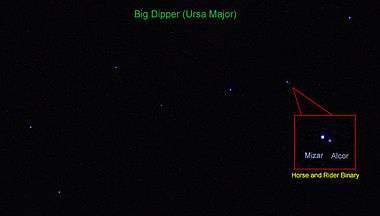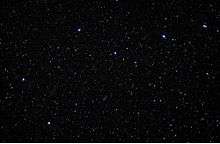Mizar and Alcor
 Mizar and Alcor in constellation Ursa Major | |
| Observation data Epoch J2000 Equinox J2000 | |
|---|---|
| Constellation | Ursa Major |
| Right ascension | 13h 23m 55.5s[1] |
| Declination | +54° 55′ 31″[1] |
| Apparent magnitude (V) | 2.27[1] |
| Characteristics | |
| Spectral type | A2Vp/A2Vp/A1m/A5V[2] |
| B−V color index | 0.02[1] |
| Astrometry | |
| Radial velocity (Rv) | −6.31[1] km/s |
| Proper motion (μ) | RA: 119.01[1] mas/yr Dec.: −25.97[1] mas/yr |
| Parallax (π) | 38.01 ± 1.71[1] mas |
| Distance | 86 ± 4 ly (26 ± 1 pc) |
| Absolute magnitude (MV) | 0.33 |
| Other designations | |
| Database references | |
| SIMBAD | data |
| Observation data Epoch J2000.0 Equinox J2000.0 | |
|---|---|
| Constellation | Ursa Major |
| Right ascension | 13h 25m 13.5s[1] |
| Declination | +54° 59′ 17″[1] |
| Apparent magnitude (V) | +3.99[3] |
| Absolute magnitude (V) | +2.00[3] |
| Distance | 81.7 ± 0.2 ly (25.1 ± 0.08 pc) |
| Spectral type | A5Vn / M[3] |
| Other designations | |
| Database references | |
| SIMBAD | data |
Mizar and Alcor are two stars forming a naked eye double star in the handle of the Big Dipper (or Plough) asterism in the constellation of Ursa Major. Mizar is the second star from the end of the Big Dipper's handle, and Alcor its faint companion.
Mizar, also designated Zeta Ursae Majoris (ζ Ursae Majoris, abbreviated Zeta UMa, ζ UMa), is itself a quadruple system and Alcor, also designated 80 Ursae Majoris (80 UMa), is a binary, the pair together forming a sextuple system. The whole system lies about 83 light-years away from the Sun, as measured by the Hipparcos astrometry satellite.[1][4][5]
Nomenclature
ζ Ursae Majoris (Latinised to Zeta Ursae Majoris) is Mizar's Bayer designation. 80 Ursae Majoris is Alcor's Flamsteed designation.
The traditional name Mizar derives from the Arabic المئزر miʼzar meaning 'apron; wrapper, covering, cover'.[6] Alcor was also originally Arabic سها suhā, meaning either the ‘forgotten’ or ‘neglected’ one.;[7] notable as a faintly perceptible companion of Mizar.
In 2016, the International Astronomical Union organized a Working Group on Star Names (WGSN)[8] to catalog and standardize proper names for stars. The WGSN's first bulletin of July 2016[9] included a table of the first two batches of names approved by the WGSN; which included Mizar for Zeta UMa and Alcor for 80 UMa. They are now so entered in the IAU Catalog of Star Names.[10]
Stellar system
Mizar is a visual double with a separation of 14.4 arcseconds, each of which is a spectroscopic binary. Its apparent magnitude is 2.23 and its spectral class is A2V.
With normal eyesight Alcor appears at about 12 minutes of arc from Mizar. Alcor is of magnitude 3.99 and spectral class A5V. It has a faint red dwarf companion separated by 1 second of arc.[11]

Mizar and Alcor's proper motions show they move together (along with the other stars of the Big Dipper - except Alpha Ursae Majoris (Dubhe) and Eta Ursae Majoris (Alkaid) - they are members of the Ursa Major Moving Group, a mostly dispersed group of stars sharing a common birth), but it has yet to be demonstrated conclusively that they are gravitationally bound. Recent studies indicate that the Alcor binary and Mizar quadruple are somewhat closer together than previously thought: approximately 74,000 ± 39,000 AU or 0.5–1.5 light years.[12]
More components of the Mizar system were discovered with the advent of the telescope and spectroscopy; an easily split visual target, Mizar was the first telescopic binary discovered, most probably by Benedetto Castelli who in 1617 asked Galileo Galilei to observe it. Galileo then produced a detailed record of the double star. Later, around 1650, Riccioli wrote of Mizar appearing as a double. The secondary star (designated Mizar B) has magnitude 4.0 and spectral class A7, and comes within 380 AU of the primary (Mizar A); the two take thousands of years to revolve around each other.
Mizar A was the first spectroscopic binary to be discovered, by Pickering in 1889. Some spectroscopic binaries cannot be visually resolved and are discovered by studying the spectral lines of the suspect system over a long period of time. The two components of Mizar A are both about 35 times as bright as the Sun, and revolve around each other in about 20 days 12 hours and 55 minutes. Mizar B was later found to be a spectroscopic binary as well, its components completing an orbital period every six months. In 1996, 107 years after their discovery, the components of the Mizar A binary system were imaged in extremely high resolution using the Navy Prototype Optical Interferometer.
Other names
Mizar is known as Vashistha and Alcor as Arundhati, two of the Saptarishi, in traditional Indian astronomy.[13] As a married couple, they are considered to symbolize marriage and in some Hindu communities to this day priests conducting a wedding ceremony allude to or point out the constellation as a symbol of the closeness marriage brings to a couple.[14]
Al-Sahja was the rhythmical form of the usual Suha. It appears as الخوّار al-Khawwar, 'the Faint One', in an interesting list of Arabic star names, published in Popular Astronomy, January 1895, by Professor Robert H. West, of the Syrian Protestant College at Beirut.
Although the statement has been made that Alcor was not known to the ancient Greeks, there is an old story that it was the Lost Pleiad Electra, which had wandered here from her companions and became Alopex, the Fox. A Latin title was Eques Stellula, the Little Starry Horseman; Eques, the Cavalier, is from the 17th-century German astronomer Bayer. Mizar and Alcor together are sometimes called the "Horse and Rider" (and popularly, in England, Jack on the Middle Horse), with Mizar being the horse. The Persian astronomer Al Biruni (973–1048 A.D.) mentioned its importance in the family life of the Arabs on the 18th day of the Syrian month Adar, the March equinox; and a modern story of that same people makes it the infant of the walidan (mother?) among the three Banat (the Mourners: Alioth, Mizar, and Alkaid).
Chinese Taoism personifies Ursa Majoris as the Lu star.
Mizar is Chickadee and Alcor is his cooking pot in the Mi'kmaq myth of the great bear and the seven hunters.[15]
Military namesakes
- USS Mizar and USNS Mizar, both United States navy ships.
- USS Alcor (AD-34) and USS Alcor (AK-259), both United States navy ships.
Test of eyesight
The ability to resolve Mizar and Alcor with the naked eye is often quoted as a test of eyesight, although even people with quite poor eyesight can see the two stars.[7] Arabic literature says that only those with the sharpest eyesight can see the companion of Mizar. The 14th century Arabian lexicographer Firuzabadi called it "Our Riddle", while the 13th century Persian astronomical writer Zakariya al-Qazwini said that "people tested their eyesight by this star." Humboldt wrote of it as being seen with difficulty, and Arago similarly alluded to it. Astronomer Sir Patrick Moore suggested that this in fact refers to another star that lies visually between Mizar and Alcor.[16]
"The Arabs in the desert regarded it as a test of penetrating vision; and they were accustomed to oppose "Suhel" to "Suha" (Canopus to Alcor) as occupying respectively the highest and lowest posts in the celestial hierarchy. So that "Vidit Alcor, at non lunam plenam", (Latin for "he saw Alcor, but not the full moon") came to be a proverbial description of one keenly alive to trifles, but dull of apprehension for broad facts."
In Japanese mythology, Alcor is known as the lifespan star or "jumyouboshi" (寿命星) as it was believed that one who could not see this star would pass away by year's end. The Japanese manga Fist of the North Star used this legend as a model for its death-omen star (死兆星), in which it was said that people who saw the star would die later in the year.
See also
References
- 1 2 3 4 5 6 7 8 9 10 11 van Leeuwen, F. (November 2007). "Validation of the new Hipparcos reduction". Astronomy and Astrophysics. 474 (2): 653–664. arXiv:0708.1752
 . Bibcode:2007A&A...474..653V. doi:10.1051/0004-6361:20078357.
. Bibcode:2007A&A...474..653V. doi:10.1051/0004-6361:20078357. - ↑ Eggleton, P. P.; Tokovinin, A. A. (2008). "A catalogue of multiplicity among bright stellar systems". Monthly Notices of the Royal Astronomical Society. 389 (2): 869. arXiv:0806.2878
 . Bibcode:2008MNRAS.389..869E. doi:10.1111/j.1365-2966.2008.13596.x.
. Bibcode:2008MNRAS.389..869E. doi:10.1111/j.1365-2966.2008.13596.x. - 1 2 3 Mamajek, Eric E.; Kenworthy, Matthew A.; Hinz, Philip M.; Meyer, Michael R. (2010). "Discovery of a Faint Companion to Alcor Using MMT/AO 5 μm Imaging". The Astronomical Journal. 139 (3): 919–925. arXiv:0911.5028
 . Bibcode:2010AJ....139..919M. doi:10.1088/0004-6256/139/3/919.
. Bibcode:2010AJ....139..919M. doi:10.1088/0004-6256/139/3/919. - ↑ Perryman, M. A. C.; Lindegren, L.; Kovalevsky, J.; Hoeg, E.; Bastian, U.; Bernacca, P. L.; Crézé, M.; Donati, F.; Grenon, M.; Grewing, M.; Van Leeuwen, F.; Van Der Marel, H.; Mignard, F.; Murray, C. A.; Le Poole, R. S.; Schrijver, H.; Turon, C.; Arenou, F.; Froeschlé, M.; Petersen, C. S. (1997). "The HIPPARCOS Catalogue". Astronomy and Astrophysics. 323. Bibcode:1997A&A...323L..49P.
- ↑ Perryman, Michael (2010). "The Making of History's Greatest Star Map". The Making of History's Greatest Star Map:. Astronomers’ Universe. Heidelberg: Springer-Verlag. Bibcode:2010mhgs.book.....P. doi:10.1007/978-3-642-11602-5. ISBN 978-3-642-11601-8.
- ↑ Wehr, Hans (1994). A Dictionary of Modern Written Arabic (Arabic-English) (4 ed.). Urbana, Illinois: Spoken Language Services. p. 17. ISBN 0879500034.
- 1 2 Bohigian, George M. (2008). "An Ancient Eye Test—Using the Stars". Survey of Ophthalmology. 53 (5): 536–9. doi:10.1016/j.survophthal.2008.06.009. PMID 18929764.
- ↑ "IAU Working Group on Star Names (WGSN)". Retrieved 22 May 2016.
- ↑ "Bulletin of the IAU Working Group on Star Names, No. 1" (PDF). Retrieved 28 July 2016.
- ↑ "IAU Catalog of Star Names". Retrieved 28 July 2016.
- ↑ Zimmerman, Neil; Oppenheimer, Ben R.; Hinkley, Sasha; Brenner, Douglas; Parry, Ian R.; Sivaramakrishnan, Anand; Hillenbrand, Lynne; Beichman, Charles; Crepp, Justin R.; Vasisht, Gautam; Roberts, Lewis C.; Burruss, Rick; King, David L.; Soummer, Rémi; Dekany, Richard; Shao, Michael; Bouchez, Antonin; Roberts, Jennifer E.; Hunt, Stephanie (2010). "Parallactic Motion for Companion Discovery: An M-Dwarf Orbiting Alcor". The Astrophysical Journal. 709 (2): 733–740. arXiv:0912.1597
 . Bibcode:2010ApJ...709..733Z. doi:10.1088/0004-637X/709/2/733.
. Bibcode:2010ApJ...709..733Z. doi:10.1088/0004-637X/709/2/733. - ↑ Mamajek, Eric E.; Kenworthy, Matthew A.; Hinz, Philip M.; Meyer, Michael R. (2009). "Discovery of a Faint Companion to Alcor Using MMT/AO 5 $\mu$m Imaging". 0911: 5028. arXiv:0911.5028
 [astro-ph.SR]. Bibcode:2009arXiv0911.5028M.
[astro-ph.SR]. Bibcode:2009arXiv0911.5028M. - ↑ V.Chandran (1993-01-01). Astronomy Quiz Book. Pustak Mahal, 1993. ISBN 978-81-223-0366-7.
... the seven rishis in the constellation Saptarishi (Ursa Major) ... In Vasishta (Zeta), its tiny companion star is named after Arundhati, the wife of Vasishta ... today known by their Arabic names Dubhe (Kratu), Merak (Pulaha), Phekda (Pulastya), Megrez (Atri), Benetnash (Marichi) and Mizar (Vasishta) ...
- ↑ M.K.V. Narayan (2007-04-01). Flipside of Hindu Symbolism: Sociological and Scientific Linkages in Hinduism. Fultus Corporation, 2007. ISBN 978-1-59682-117-0.
... At this time, the pundit shows the couple the Arundhati star in the sky to suggest closeness of the married couple. ... the star Vasishta of the Big Dipper constellation (Saptarishi Mandalam) and it is the star system called Mizar ...
- ↑ The Celestial Bear, A Micmac Legend
- ↑ Moore, Patrick; Watson, John (2012). "Observing the Stars and Galaxies". Astronomy with a Budget Telescope. Patrick Moore's Practical Astronomy Series. p. 65. doi:10.1007/978-1-4614-2161-0_5. ISBN 978-1-4614-2160-3.
External links
- Mizar and Alcor articles at Jim Kaler's Stars website
- First very high resolution imaging of Mizar A (using aperture synthesis)
- A New View Of Mizar (a comprehensive article about the system)
- Mizar and Alcor on WikiSky: DSS2, SDSS, GALEX, IRAS, Hydrogen α, X-Ray, Astrophoto, Sky Map, Articles and images
Coordinates: ![]() 13h 23m 55.5s, +54° 55′ 31″
13h 23m 55.5s, +54° 55′ 31″